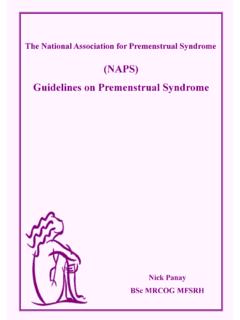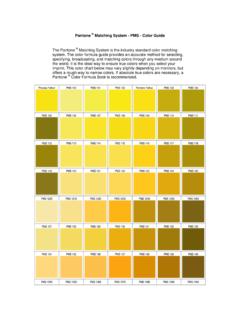Transcription of (NAPS) Guidelines on Premenstrual Syndrome
1 (NAPS) Guidelines on Premenstrual Syndrome The National Association for Premenstrual Syndrome Nick Panay BSc MRCOG MFSRH NAPS Guidelines on Guidelines on Premenstrual Syndrome Nick Panay BSc MRCOG MFSRH Chairman of the National Association for Premenstrual Syndrome Director of West London Menopause & PMS Centre Consultant Gynaecologist Imperial College Healthcare NHS Trust & Chelsea and Westminster NHS Foundation Trust Honorary Senior Lecturer, Imperial College London INTRODUCTION These Guidelines have been prepared by Mr Nick Panay, Chairman of NAPS for the benefit of both sufferers and health professionals. The Guidelines aim to provide clear information at a time when so much controversy exists as to the causality and management of PMS. Guidelines on the definition and management of PMS are essential to encour-age the acceptance of the condition by patients, health professionals and regulatory authorities.
2 The text aims to distil the evidence base into eas-ily digestible and understandable prose as such, extensive references will not be provided but are available from the Green Top Guidelines of the Royal College of Obstetricians and Gynaecolo-gists for the interested reader. The treatment algorithm provides a summary of interventions which might be instituted at levels of the severity of symptoms. In the Appendix, levels of recommendation are given for the medi-cal interventions according to accepted RCOG evidence levels with also key references and fur-ther reading. DEFINITION Many women experience mild physical and emo-tional PMS symptoms which are not particularly troublesome. However, when severe, these symp-toms can lead to a breakdown in interpersonal relationships and to an interference with normal activities.
3 A working definition of PMS is a con-dition which manifests with distressing physical, behavioural and psychological symptoms not due to organic or underlying psychiatric disease, which regularly recurs during the luteal phase of each menstrual (ovarian) cycle and which disap-pears or significantly regresses by the end of men-struation. The severity of symptoms is judged according to the degree of interference with day-to-day activities and relationships. Premenstrual exaggeration or exacerbation of symptoms can also occur, though this is not regarded as the core diagnosis. Premenstrual Dysphoric Disor-der (PMDD) is the American Psychiatric Associa-tion s definition of severe PMS in the Diagnostic and Statistics manual - Version IV AETIOLOGY The precise aetiology of PMS remains unknown but cyclical ovarian activity and the effect of es-tradiol and progesterone on the neurotransmitters serotonin and gamma-aminobutyric acid (GABA) appear to be key factors.
4 Absence of PMS before puberty, in pregnancy and after the menopause supports the theory that cyclical ovarian activity is important. Rapidly changing estradiol levels, not only premenstrually but also postnatally and peri-menopausally lead to this triad of hormone de-pendent depressive disorders often in the same predisposed individual. Recent work has shown that the risk for PMDD is associated with a ge-netic variation in ESR1 (Estrogen Receptor [ER] alpha) gene but more work is required to confirm and define this genetic predisposition. PREVALANCE The reported prevalence of moderate to severe PMS varies between 3% and 30%, depending on the population studied, and is likely to be under reported, especially by the ethnic minorities. The incidence of severe PMS or PMDD appears to be 5 to 8%. PMS appears less prevalent in women who are on hormonal contraception, of normal weight and perform exercise.
5 DIAGNOSIS Crucial to the management of PMS is the need to make the correct diagnosis. This cannot be accu-rately established by retrospective recall. It needs to be made by the prospective logging of symp-toms by the patient, ideally over two cycles. A symptom chart/diary which can be filled in online is available on the NAPS website ( ). Alternatively, the blue moons diary could be used. The chart/diary should continue to be filled in when treatment has been started to give an objective indication of re-sponse to therapy. Common Symptoms of PMS (over 150 identified) TREATMENT General Principles of Treatment When managing women with PMS, there are cer-tain principles which should be adhered to. Even though not evidence-based, there is little doubt that reduction of stress, for instance, is a great help in ameliorating symptoms.
6 Also, dietary measures such as avoidance of carbohydrate binges and limitation of alcohol and caffeine in-take is often of benefit. There are data from non-randomised trials that exercise improves PMS symptoms. However, in cases of moderate to se-vere PMS, it is important that medical therapy is instituted sooner rather than later to avoid unnec-essary suffering. Women with marked underlying psychopathology as well as PMS should be re-ferred to a psychiatrist. Symptom charts/diaries should be used to assess the effect of treatment. Service Delivery Primary care should be able to deal with most cases of PMS. Awareness of the condition and training in its management are essential. Ideally, women with severe PMS should be treated by a multidisciplinary team which might comprise a hospital or community gynaecologist, psychiatrist or psychologist, dietitian and counsellor.
7 While such services are rarely provided in any NHS set-ting, referral to a gynaecologist should be re-served for women who have been fully evaluated as having severe PMS and when simpler forms of therapy have been explored. COMPLEMENTARY THERAPIES (CAMs) When treating women with PMS, complementary medicines may be of benefit, but clinicians need to consider that data from clinical studies are lim-ited and underpowered. Interactions with conven-tional medicines should also be considered. It is difficult to assess the true value of most of these therapeutic interventions because they are freely available without prescription or physician recom-mendation, and with little regulation of efficacy or safety. Most are not licensed or registered for the treatment of PMS. The regulatory authorities are aiming to rectify the situation by insisting that all complementary therapies are registered by 2011 or withdrawn from sale.
8 This section reviews the recent evidence for some of the evidence-based PHYSICAL SYMPTOMS Breast tenderness, skin rashes Bloating, weight gain, clumsiness Headaches, backache PSYCHOLOGICAL & BEHAVIOURAL SYMPTOMS Mood swings, depression Tiredness, fatigue or lethargy, irritability Anxiety, feeling out of control Reduced cognitive ability, aggression, anger Sleep disorders, , food cravings alternative interventions which have been used to treat PMS. Treatments have been selected where reasonable efficacy data exist (randomised controlled data if possible). Vitamin B6 OTC IS Vitamin B6 is often used to treat Premenstrual Syndrome without clear evidence of its efficacy. The recommended dietary allowance for Vitamin B6 is around and deficiency of Vitamin B6 is rare. Due to the unproven efficacy of Vita-min B6 in treating Premenstrual Syndrome , a sys-tematic review of published and unpublished ran-domised placebo controlled trials of effectiveness of Vitamin B6 in the management of Premenstrual Syndrome has been undertaken.
9 This showed a marginal benefit for using Vitamin B6. There is no rationale for giving daily doses of Vitamin B6 in excess of 100mg, especially following recommen-dation from the Department of Health and the Medicine Control Agency in 1999 to restricting the dose of Vitamin B6 available generally to 10mg and to limit the dose sold by a pharmacist to less than 50mg. Recommendation (A): Insufficient evidence of efficacy is available to give a recommenda-tion for using Vitamin B6 in the treatment of Premenstrual Syndrome . MagnesiumOTC Preliminary small studies suggest that magne-sium may also be helpful in PMS. More data would be desirable. Recommendation (B): There is some evidence that regular use of magnesium supplements is of benefit in managing Premenstrual Syndrome . Calcium / Vitamin DOTC Studies suggest that blood calcium and Vitamin D levels are lower in women with PMS and that cal-cium supplementation may reduce symptom se-verity, but it is unknown whether this may prevent the initial development of PMS.
10 In a recent case control study, after adjustment for risk factors, women in the highest quintile of total Vitamin D intake (median, 706 IU/d) had a relative risk of (95% confidence interval, ) com-pared with those in the lowest quintile (median, 112 IU/d) (P = .01 for trend). The intake of skimmed or low-fat milk was also associated with a lower risk (P<.001). A high intake of calcium and Vitamin D may therefore reduce the risk of PMS but large-scale clinical trials addressing this issue are required. At present, the only interven-tional data are from small trials. Recommendation (B): Given that calcium and Vitamin D may also reduce the risk of osteopo-rosis and some cancers, clinicians may consider recommending these nutrients even for women with PMS but more data are required to deter-mine efficacy and to optimise regimens. Isoflavones Soy/Red CloverOTC In a 24-week, double-blind study, 49 women with menstrual migraines received either placebo or a combination supplement containing Soy isofla-vones, Dong Quai, and Black Cohosh extracts.









